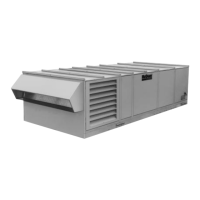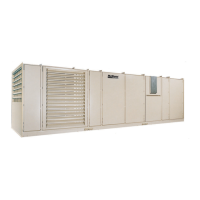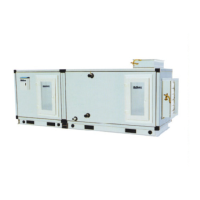IM-738 Page 51
Sequences of Operation
The following sequences of operation are for a typical "C" vin-
tage applied rooftop unit that is equipped with MicroTech II,
an economizer, 4 compressor/4stage cooling, 3 to 1 turn down
burner, variable frequency drives (VFD), a return air fan and
an external time clock. These sequences describe the ladder
wiring diagram logic in detail; refer to “Wiring Diagrams” on
page 54 as you read them. Note that your unit's sequences of
operation may vary from those described here. Refer to the
wiring diagrams supplied with the unit for exact information.
For detailed description of operation information relating to
the MicroTech II controller's software, refer to the appropri-
ate operation manual (see Table 1 on page 3). These manuals
describe the various setpoints, parameters, operating states,
and control algorithms that affect rooftop unit operation.
Power-up
When primary power is connected to the unit, 115VAC power
is fed through control circuit transformer TI and control cir-
cuit fuse FI (line 200) to compressor crankcase heaters HTR-1,
HTR-2, HTR-3 and HTR-4 (lines 825, 875, 823 and 873).
When system switch S1 (line 205) is closed, low voltage trans-
formers T2 (line 205), T3 (line 300)and T9 (line 805) are ener-
gized, and 115VAC power is supplied to the following:
• Smoke detectors (line 284)
• Economizer actuator ACT3 (line 336)
• Supply fan vane actuator ACT1 (line 340) or
• M30A to energize the supply fan VFD (line 311)
• Return fan vane actuator ACT2 (line 346) or
• M40A to energize the return fan VFD (line 316)
• Heating control panel
• Compressor circuit switches CSI and CS2 (lines 831 and 881)
Transformer T2 supplies 24VAC power to terminals 24V &
24C on the main control board MCB (lines 207 and 208). By
way of terminal TB6-48 (lines 206), transformer T2 supplies
24VAC power to the following:
• Switch S7 On-Auto-Off (line 223)
• Enthalpy sensor OAE (line 265)
• External time clock contacts (line 222)
• External exhaust fan status contacts (line 273, VAV only)
• Airflow interlock switch PC7 (line 248)
• Dirty filter switches PC5 and PC6 (lines 256 and 260)
• Duct high limit switch DHL (line 276, DTC only)
• Gas furnace alarm relay R24 (line 244)
• Freezestat switch FS1 (line 251, hot water or steam heat only)
• Smoke detectors SDI and SD2 (line 254)
When the field supplied Cool Enable switch is in the "off"
position, field wiring terminal 105 is de-energized (line 233).
Binary input MCB-BI3 will be de-energized and the cooling
will be disabled. When the field supplied Heat Enable switch
is in the "off" position, field wiring terminal 106 is de-ener-
gized (line 242). Binary input MCB-BI4 will be de-ener-
gized and the heating will be disabled. Note: Unit ships with
factory installed jumpers between 101 and 105 and between
101 and 106.
Fan Operation
When the supply and return fans are commanded to start by
the Microprocessor Control Board (MCB), the unit enters the
Startup Initial operating state. As a result, a 3-minute timer is
set, output MCB-BO3 (line 394) energizes and relay R26 ener-
gizes (line 393). On VAV units with inlet vanes, outputs MCB-
BO14 and MCB-BO16 energize (lines 344, 342), causing the
supply and return fan inlet vanes to open. When the vanes
open to their minimum positions, MCB-BO14 and MCB-
BO16 are de-energized, causing the inlet vanes to hold.
After the 3-minute timer expires, the unit enters the Recircu-
late operating state. As a result, output MCB-BO1 energizes
relay R67 (line 304). This gives a start signal to supply fan
drive AFD10 (line 343). Four seconds after MCB-BO1 is
energized, output MCB-BO2 energizes relay R68 (line 305).
This gives a start signal to return fan drive AFD20 (line 343).
Overload relays OL9, OL1O, OL19, and OL20 (line 311) pro-
tect the fans from excessive current draw. If either the supply
or return fan is drawing excessive current, one of the relays
will open its contacts and cause both fans to stop.
Within 120 seconds after the fans start, the controller expects
airflow switch PC7 (line 248) to close and thus energize
binary input MCB-BI6. (If MCB-BI6 does not energize, the
controller will assume the fans did not start. It will then shut
down the unit and generate an alarm.)
During the Recirculate operating state, the outside air damper
is held closed. The controller does this by energizing output
MCB-BO5 (line 338). On VAV units, output MCB-BO12, the
VAV box output, is also de-energized (line 395) during the
Recirculate state.
On VAV units, the supply fan adjustable frequency drive
(AFD10) or inlet vanes (ACT1) are modulated to maintain
the duct static pressure setpoint. When energized, output
MCB-BO14 drives AFD10/ACT1 towards increased capac-
ity, and MCB-BO13 drives them towards decreased capacity
(line 344). On VAV units or CAV units equipped with return
fan capacity control, the adjustable frequency drive (AFD20)
or the return fan vanes (ACT2) are modulated to maintain an
acceptable building static pressure (using either VaneTrol
logic or direct measurement of building pressure: see the
appropriate OM for more information). When energized,
output MCB-BO16 drives AFD20/ACT2 towards increased
capacity, and MCB-BO15 drives them towards decreased
capacity (line 342).
Economizer Operation
When the outdoor air is suitable for free cooling, the switch
in enthalpy sensor OAE is in position "3" (line 267) energiz-
ing binary input MCB-BI11. When MCB-BI11is energized,
the economizer is enabled. (Note: If selected from the key-
pad, the enthalpy decision can be made based on outdoor
temperature. In that condition, if the outdoor air temperature
is less than or equal to the changeover setpoint, the econo-
mizer is enabled.) If cooling is required, the economizer
dampers (ACT3) are modulated to maintain the discharge air
temperature setpoint. When energized, output MCB-BO6

